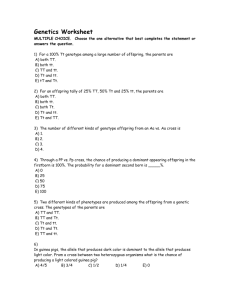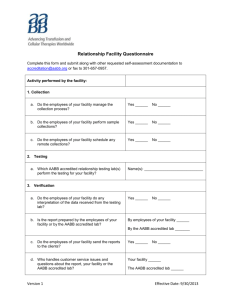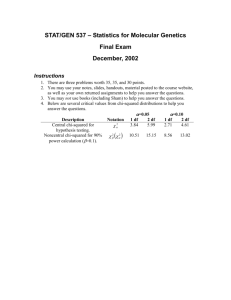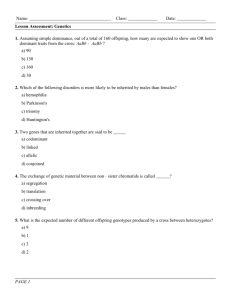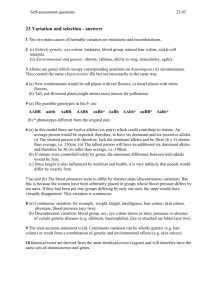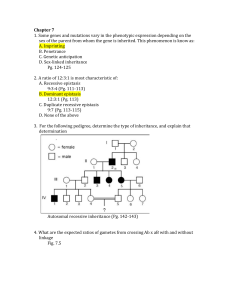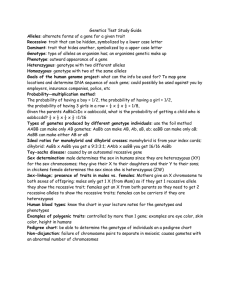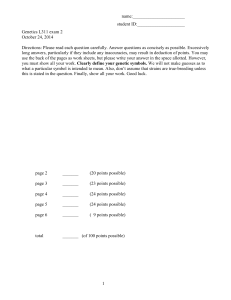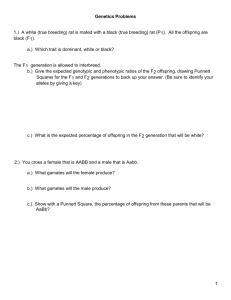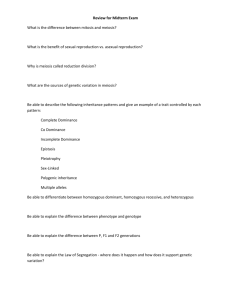punnet squares, crosses, linked genes and pedigreesppt
advertisement
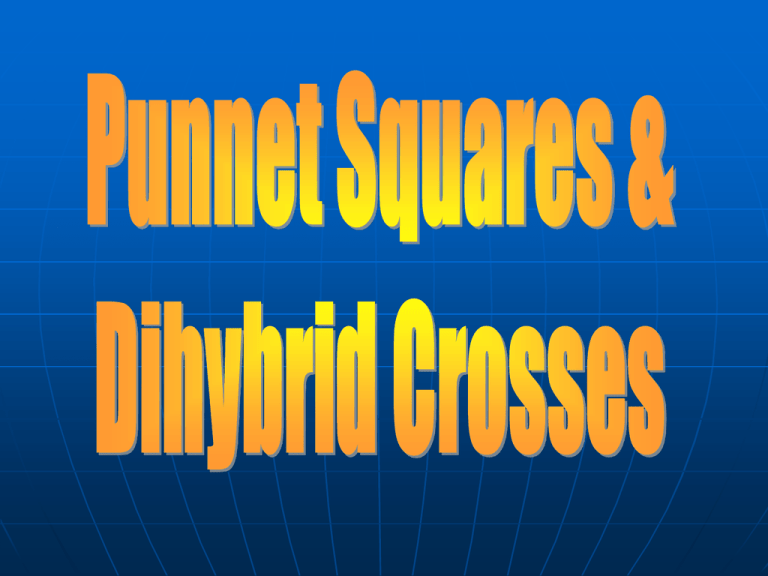
Back to Basics What are their phenotypes? How would you describe their genotypes? A is a dominant characteristic – orange feathers. a is a recessive characteristic – blue feathers. This bird has two genes for orange feathers. Its genotype is AA. This bird has two genes for blue feathers. Its genotype is aa. Punnet Squares Which one is the female? How do you know? What if we wanted to look at two features at once? Feather color -- ORANGE or blue Crest? -- CREST or no crest A – Orange What are the possible genotypes of these two birds? a - blue C – Crest c – no crest Which alleles are dominant? Dihybrid Cross Feather color -- ORANGE or blue Crest? -- CREST or no crest Genotype: Aacc Possible gametes: Ac; Ac; ac; ac Genotype: aaCc Possible gametes: aC; ac; aC; ac Dihybrid Cross Feather color -- ORANGE or blue Crest? -- CREST or no crest Genotype: Aacc Possible gametes: Ac; Ac; ac; ac Genotype: aaCc Possible gametes: aC; ac; aC; ac Dihybrid Cross What are the possible genotypes of the offspring? What are the phenotypic ratios? What are the possible phenotypes of the offspring? Another example MA = lots of melanin mA = small amount of melanin MB = lots of melanin mB = small amount of melanin mA mB MAmB mAMB MAMB Linked Genes These are: • Genes that have loci that are physically close to each other on the same chromosome • less likely to be independently assorted (separated from each other) during crossing over in meiosis Linked Genes These are: • Genes that have loci that are physically close to each other on the same chromosome • less likely to be independently assorted (separated from each other) during crossing over in meiosis Because… A crossing over point is more likely to occur on a chromosome between two genes that are widely separated compared to genes that are closer together For example: So what?? This means that: • Linked genes are almost always inherited together as a single unit from one of the two parents • A dihybrid cross cannot be used to estimate the probability of inheriting different combinations of traits So how can we tell if genes are linked? By looking at the results of a test cross: • ABab x abab = ABab; Abab; aBab; abab • If all offspring occur in equal amounts, genes are not linked • If linked, the vast majority of the offspring will be: ABab or abab Because AB or ab will be inherited as single units from one parent whilst only an ab combination an be inherited from the other. Test crosses always include one homozygous recessive parent and one heterozygous parent So how can we predict outcomes of linked gene crosses? This depends on the distance between the linked genes on the chromosome This is measured by map units The number of map units correlates to the percentage of offspring that have recombined traits For example In the cross ABab x abab If A and B are 6 map units apart the recombined alleles Ab and aB will only have a probability of making up 6% of the total offspring (3% each) Parent Gametes AB ab Ab aB ab AaBb aabb Aabb aaBb ab AaBb aabb Aabb aaBb ab AaBb aabb Aabb aabb ab AaBb aabb Aabb aabb AaBb 47% aabb 47% Aabb 3% aaBb 3% Offspring Additional examples In the cross CDcd x cdcd 8 map units apart recombined alleles Cd and cD will only have a probability of making up 8% of the total offspring (4% each) In the cross EFef x efef 12 map units apart recombined alleles Ef and eF will only have a probability of making up 12% of the total offspring (6% each) Parent Gametes cd Offspring CD cd Cd cD CdDd ccdd Ccdd ccDd 46% 46% 4% 4% Parent Gametes ef Offspring EF ef Ef eF EeFf eeff Eeff eeFf 44% 44% 6% 6% Pedigree Charts Pedigrees are diagrams which demonstrate the inheritance of a particular trait within a family Pedigrees can indicate the inheritance modes of particular traits Pedigree Symbols I, II, III, IV – 1st, 2nd, 3rd, 4th generations respectively Are males and females equally affected? Pedigrees of x-linked recessive traits: • Males affected more commonly • All sons of affected female will also be affected • All children of 2 affected individuals will also have the trait Are males and females equally affected? Do all affected individuals have at least one affected parent? Autosomal Dominant Pedigrees of autosomal dominant traits: • Males and females affected equally (autosomal) • Affected individuals must have at least one affected parent Traits cannot ‘skip’ generations • No carriers Are males and females equally affected? Do all affected individuals have at least one affected parent? Autosomal Recessive Pedigrees of autosomal recessive traits: • All children of 2 affected parents will also have the trait • Some affected individuals might have 2 unaffected parents if both are carriers: Can ‘skip’ generations X-linked Dominant Pedigrees of x-linked dominant traits: • All daughters of affected males will also have the trait • Female with the trait can pass it on to both daughters and sons • No carriers
